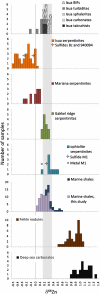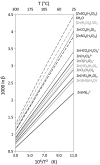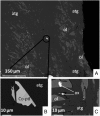Early Archean serpentine mud volcanoes at Isua, Greenland, as a niche for early life
- PMID: 22006301
- PMCID: PMC3203773
- DOI: 10.1073/pnas.1108061108
Early Archean serpentine mud volcanoes at Isua, Greenland, as a niche for early life
Abstract
The Isua Supracrustal Belt, Greenland, of Early Archean age (3.81-3.70 Ga) represents the oldest crustal segment on Earth. Its complex lithology comprises an ophiolite-like unit and volcanic rocks reminiscent of boninites, which tie Isua supracrustals to an island arc environment. We here present zinc (Zn) isotope compositions measured on serpentinites and other rocks from the Isua supracrustal sequence and on serpentinites from modern ophiolites, midocean ridges, and the Mariana forearc. In stark contrast to modern midocean ridge and ophiolite serpentinites, Zn in Isua and Mariana serpentinites is markedly depleted in heavy isotopes with respect to the igneous average. Based on recent results of Zn isotope fractionation between coexisting species in solution, the Isua serpentinites were permeated by carbonate-rich, high-pH hydrothermal solutions at medium temperature (100-300 °C). Zinc isotopes therefore stand out as a pH meter for fossil hydrothermal solutions. The geochemical features of the Isua fluids resemble the interstitial fluids sampled in the mud volcano serpentinites of the Mariana forearc. The reduced character and the high pH inferred for these fluids make Archean serpentine mud volcanoes a particularly favorable setting for the early stabilization of amino acids.
Conflict of interest statement
The authors declare no conflict of interest.
Figures



Similar articles
-
A vestige of Earth's oldest ophiolite.Science. 2007 Mar 23;315(5819):1704-7. doi: 10.1126/science.1139170. Science. 2007. PMID: 17379806
-
Vestiges of life in the oldest Greenland rocks? A review of early Archean geology in the Godthabsfjord region, and reappraisal of field evidence for > 3850 Ma life on Akilia.Precambrian Res. 2000;103(3-4):101-24. doi: 10.1016/s0301-9268(00)00089-9. Precambrian Res. 2000. PMID: 11577752
-
Evaluating the multiple sulfur isotope signature of Eoarchean rocks from the Isua Supracrustal Belt (Southwest-Greenland) by MC-ICP-MS: Volcanic nutrient sources for early life.Geobiology. 2024 Mar-Apr;22(2):e12595. doi: 10.1111/gbi.12595. Geobiology. 2024. PMID: 38596869
-
Geological constraints on detecting the earliest life on Earth: a perspective from the Early Archaean (older than 3.7 Gyr) of southwest Greenland.Philos Trans R Soc Lond B Biol Sci. 2006 Jun 29;361(1470):851-67. doi: 10.1098/rstb.2006.1836. Philos Trans R Soc Lond B Biol Sci. 2006. PMID: 16754603 Free PMC article. Review.
-
Serpentinite mud volcanism: observations, processes, and implications.Ann Rev Mar Sci. 2012;4:345-73. doi: 10.1146/annurev-marine-120710-100922. Ann Rev Mar Sci. 2012. PMID: 22457979 Review.
Cited by
-
Mariana serpentinite mud volcanism exhumes subducted seamount materials: implications for the origin of life.Philos Trans A Math Phys Eng Sci. 2020 Feb 21;378(2165):20180425. doi: 10.1098/rsta.2018.0425. Epub 2020 Jan 6. Philos Trans A Math Phys Eng Sci. 2020. PMID: 31902339 Free PMC article.
-
Oxidative elemental cycling under the low O2 Eoarchean atmosphere.Sci Rep. 2016 Feb 11;6:21058. doi: 10.1038/srep21058. Sci Rep. 2016. PMID: 26864443 Free PMC article.
-
The significance of Mg in prebiotic geochemistry.Geobiology. 2012 Jul;10(4):269-79. doi: 10.1111/j.1472-4669.2012.00323.x. Epub 2012 Mar 20. Geobiology. 2012. PMID: 22429303 Free PMC article.
-
A self-sustaining serpentinization mega-engine feeds the fougerite nanoengines implicated in the emergence of guided metabolism.Front Microbiol. 2023 May 15;14:1145915. doi: 10.3389/fmicb.2023.1145915. eCollection 2023. Front Microbiol. 2023. PMID: 37275164 Free PMC article.
-
Isotope composition and volume of Earth's early oceans.Proc Natl Acad Sci U S A. 2012 Mar 20;109(12):4371-6. doi: 10.1073/pnas.1115705109. Epub 2012 Mar 5. Proc Natl Acad Sci U S A. 2012. PMID: 22392985 Free PMC article.
References
-
- Corliss JB. The flow of energy, natural learning systems and the creation of life on Earth. Acta Astronaut. 1989;19:869–873.
-
- Wächtershäuser G. Groundworks for an evolutionary biochemistry: The iron-sulphur world. Progr Biophys Mol Biol. 1992;58:85–201. - PubMed
-
- Cody GD, et al. Geochemical roots of autotrophic carbon fixation: hydrothermal experiments in the system citric acid, H2O-( ± FeS)-( ± NiS) Geochim Cosmochim Acta. 2001;65:3557–3576.
-
- Holm NG, Charlou JL. Initial indications of abiotic formation of hydrocarbons in the Rainbow ultramafic hydrothermal system, Mid-Atlantic Ridge. Earth Planet Sci Lett. 2001;191:1–8.
Publication types
MeSH terms
Substances
LinkOut - more resources
Full Text Sources
Medical
Miscellaneous

